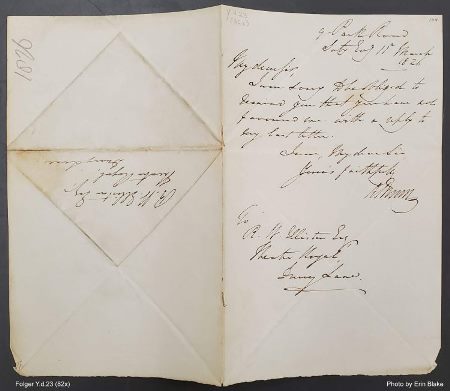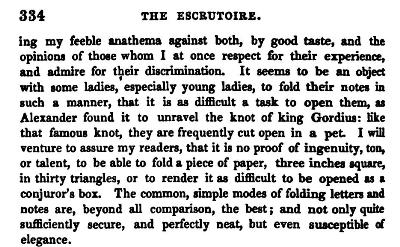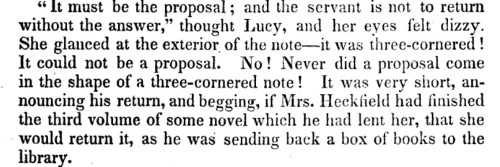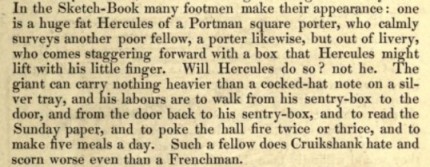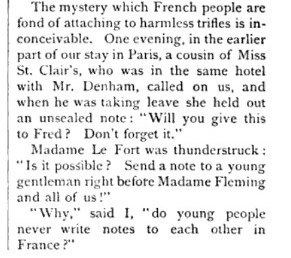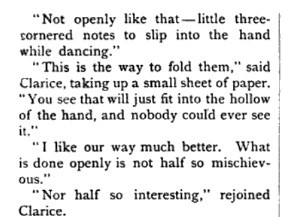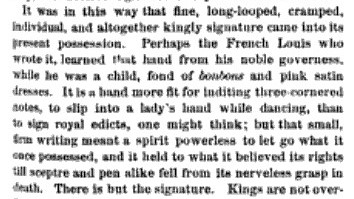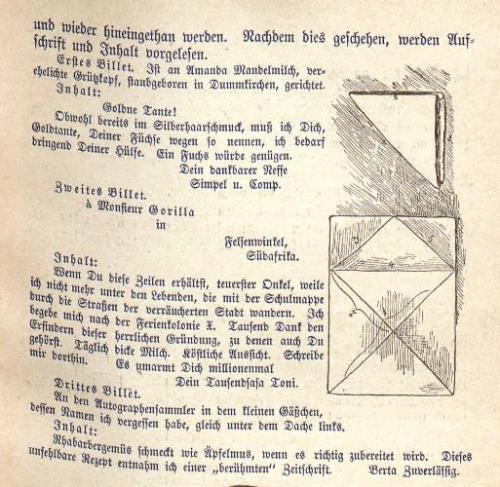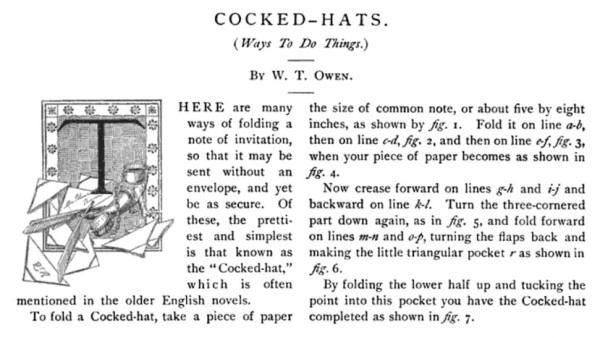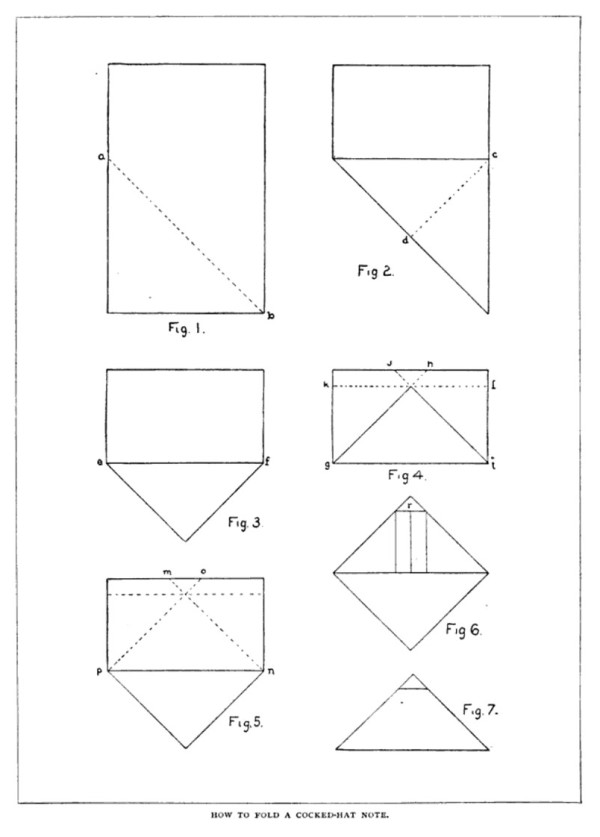| The Public Paperfolding History Project
Last updated 11/12/2025 x |
|||||||
| Triangular Notes | |||||||
| This
page is being used to collect information about the
history of Triangular Notes. Please contact me if you
know any of this information is incorrect or if you have
any other information that should be added. Thank you. There appear to have been several different ways of folding Triangular Notes. For specific methods see entries for 1887 and 1888 below. The entry for 1845 suggests more complicated methods may also have existed. In English literature, Triangular Notes are commonly referred to as either cocked-hat notes, three-cornered notes, triangular billet-doux, three-cornered billet doux or tri-cornered billet doux. There afe probably other variations. These terms are probably interchangeable and it is unlikely they refer to notes folded in different ways. Triangular Notes seem to have been used mostly for informal notes rather than for formal letters (see entry for 1800). References are often to this form of note being used for love-letters.. The earliest reference I have found to a 'triangular billet-doux' is from 1831, to a 'three-cornered note' from 1833, and to a 'cocked-hat note' from 1839. Earlier references to informal notes / love-letters often just use the term 'billet-doux' or 'billet d'amour'. It is clear that these earlier notes were also folded, perhaps in the same way as Triangular Notes, but evidence to prove or disprove this conjecture is lacking. The only evidence I have to date can be found in Volume XV of the the 'Wiltshire Archaeological and Natural History Magazine', which was published in 1875 and refers to 'the good old-fashioned three-cornered shape of a true billet-doux' (see below), but this is too late to be conclusive. There are hundred of references to Triangular Notes, under their various names, in English literature. I have generally only included a reference on this page if it is of an early date or otherwise of particular interest. ********** Chronology 1800 'The New and Complete Universal Letter-Writer' by Henry Hogg and Rev George Brown was published in London in 1800. It refers to notes folded in a triangular or diamond manner and states that these should only be used for 'notes' ie informal correspondence.
********** 1826 The earliest example of a Triangular Letterfold that I know of is in the collection of the Folger Shakespeare Library and was written in 1826. See online article 'Re-discovering three-cornered notes' by Erin Blake.
********** 1829 'The Young Lady's Book', which was published by Vizetelly, Branston and Co in London, in 1829, contains mention of folding three inch square pieces of paper into 'thirty triangles' (presumably actually thirty-two).
********** 1831 The October 1831 issue of 'The Royal Lady's Magazine' contains two references to 'triangular billet doux'.
********** 1833 'Recollections of a Chaperon' by Lady Dacre, which was published in London and New York in 1833, contains an early reference to a three-cornered note.
********** 1839 There is reference to a 'cocked-hat note' in the August 1839 issue of 'The Literary Garland'.
********** 1840 There is reference to a 'cocked-hat note' in 'An Essay on the genius of George Cruikshank' by William Makepeace Thackeray, which was published by Charles Reynell in London in 1840. At first sight this seems to suggest that the George Cruikshank illustration referred to shows a 'cocked-hat note on a silver tray' but unfortunately this is not the case.
********** 1845 'Tom Racquet' by Charles W Manby, which was published in London in 1845, contains mention of a 'mysteriously folded' three-cornered note and of a 'little pink cocked hat of a note'.
***
***
********** 1850 There is also reference to a 'cocked hat note' in 'David Copperfield' by Charles Dickens which was serialised in 1849 / 50 and published in book form in 1850.
********** 1859 There is another reference to a cocked-hat note in Household Words, a weekly journal conducted by Charles Dickens, of 23rd April 1859.
********** 1861 There is a reference to 'three-cornered notes and billet-doux' in the September 1861 issue of Godey's Lady's Book in a brief article describing how good submissions to the magazine are to be made.
********** 1875 Volume XV of 'Lippincott''s Magazine', which was published in 1875, contains reference to 'three-cornered notes to slip into the hand while dancing'.
********** Volume XV of the the 'Wiltshire Archaeological and Natural History Magazine', which was published in 1875, refers to 'the good old-fashioned three-cornered shape of a true billet-doux.'
********** 1876 There is another reference to a 'cocked-hat note' in Chambers Journal for 22nd April 1876.
********** 1877 Baldwin's Monthly for October 1875 contains reference to 'three-cornered notes, to slip into a ladies hand while dancing'.
********** 1882 There is a description of a paperfolding game in 'Spiel und Sport' by Dr Jan Daniel Georgens, which was published by Verlag und Drud von Otto Spamer in Leipzig and Berlin in 1882, which involves the folding of a 'closed letter in the shape of a triangle'.
Roughly paraphrased this passage reads: 'Paper games. An octave sheet should be folded into a closed letter in the shape of a triangle. Each person takes it in turn to make a fold. Anyone who folds the wrong way pays a forfeit. A second challenge is to fold a closed letter with eight squared fractions from an octave sheet.' ********** 1883 The May 1883 issue of 'The English Household Magazine' contains mention of a Triangular Letterfold which is called first 'a small note folded in the form of a cocked hat' and then 'the three cornered note', thus showing that the two descriptions could be used interchangeably. **********
********** 1885 In an article in The Sydney Mail of 20th June 1885.
********** 1887 'Neues Spielbuch fur Madchen', by Jeanne Marie von Ganette-Georgens, which was published in Berlin in 1887, contains an explanation of a game involving folding Triangular Letter Folds.
********** 'The neat three-cornered notes that old English ladies fold' are mentioned in an article in the August 1887 issue of St Nicholas magazine. ********** 1888 'Wide Awake: Volume Z', which was published by D Lothrop Company in Boston in 1888, contains an article about the Cocked-Hat Note which says 'There are many ways of folding a note of invitation, so that it may be sent without an envelope, and yet be as secure. Of these, the prettiest and simplest is that known as the 'Cocked-hat', which is often mentioned in the older English novels' and gives the folding instructions.
********** 1939/45 During the Second World War the format of Triangular Notes was famously used by Russian soldiers to write home from the front lines. This nor only saved on envelopes but allowed the censors to open, check and refold the letters en route. See this blog post by Poemas del río Wang: Triangular letters ********** |
|||||||

